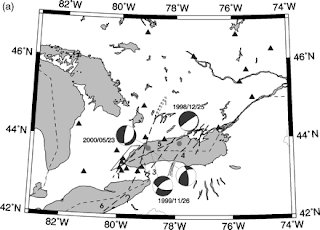This started with a series of emails from a house owner in Burlington. I said that if you are on soft ground, and felt the recent Ontario earthquake strongly, then get an earthquake rider on the house. I estimate $20K damage over 20 years (drywall, furnishings, windows). Today, instead of ranting, I'll go over an interesting old paper in the BSSA. Text copy in italics, interspersed with my comments.
Bulletin of the Seismological Society of America; October 2004; v. 94; no. 5; p. 1902-1918; DOI: 10.1785/012003007
© 2004 Seismological Society of America
Seismicity of the Southern Great Lakes: Revised Earthquake Hypocenters and Possible Tectonic Controls
Savka Dineva, David Eaton and Robert Mereu
Abstract (extract)
Three preliminary focal mechanisms of earthquakes with magnitudes mN 3.1 to 3.8 show unusual normal faulting, with nodal planes in almost the same direction as the magnetic trends, N42°E-N52°E. Proximity of the earthquake clusters to large bodies of water, coupled with colinearity with magnetic anomaly trends, suggests that both surface water and pre-existing basement structures may play significant roles in controlling intraplate seismicity in the southern Great Lakes region.
Historical seismicity to 1990, locations are weighted to population centres.
Tectonic Map, note Grenville Fault Zone goes right by the Bruce Underground Nuclear Waste Facility
B-curve. The big earthquakes are Cleveland, but fit right in the pattern.
The b-curve shows our odds of getting a 'big one'. Note that if we go to 1 in 100, or 1 in 1000, we are going quite big! This curve would clip (go vertical) at M7, due to the 30km length of the Ham-Burl fault.
Beach balls showing alignment with fault.
Cross-sections showing depth.
Their conclusions are rather weasely, like somebody finding evidence that the sun is more important than CO2 for global climate. But these last figures tell all. Note that there is some depth to the Hamilton fault, but shallower as you go into Buffalo. This shows a perfect relationship between causative fault, and surrounding stress disturbance. All of this is perfect for predicting a likely large earthquake. When it happens, don't say we didn't warn you!





3 comments:
Just found out the earthquake insurance rider is quite cheap, but with a 5% deductible. For the lowlands of Burlington, you'll have the same insurance advantage as Christchurch NZ. :)
Hi Harold,
I am the home owner you spoke about in Burlington. Are you saying that we should plan on $20k in damage over 20 years? That would be $1k per year or $100k for a 100 year event. This seems very high to me as that would put the 1 in 100 year earthquake event at M6 or higher!! There has never been a damaging earthquake in this area since European settlement began almost 300 years ago. I always thought there was a relationship between many small earthquakes and infrequent big ones. Even if we averaged one M3 every 10 years, that would mean 1 M4 every 100 years, 1 M5 every 1000 years and so on. Or am I missing something?
The b-curve is a bit flatter than the 1 in 10 rule. The regional M5's are about every 10 years. Specifically on the h-b fault, might be 1 in 100 years. Historical activity for this area is very high.
In general think of this as a chunk of the San Andreas, except it's 10 times smaller, and 10 times slower strain rate, but 10 times greater felt area per quake. Our soils can amplify 10 times greater than Cal. :)
Post a Comment